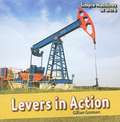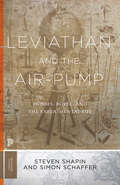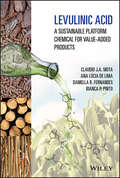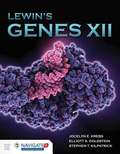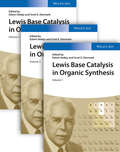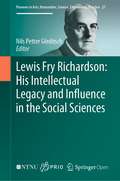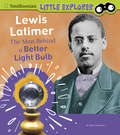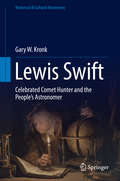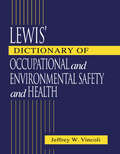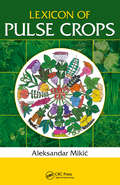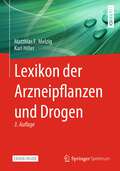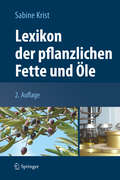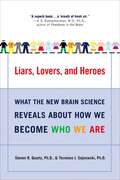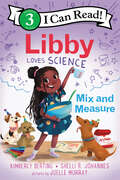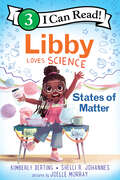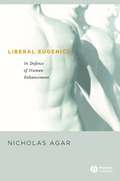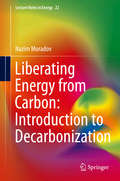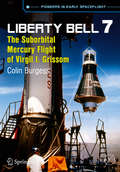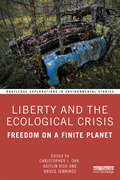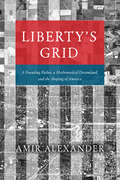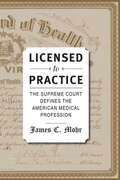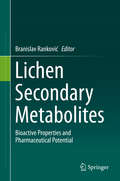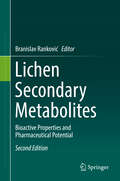- Table View
- List View
Levers In Action (Simple Machines at Work)
by Gillian GosmanLevers are everywhere. Readers will learn about historical and present-day uses of levers and how levers make countless everyday activities much easier. A simple experiment is included with step-by-step instructions.
Levers and Pulleys: FOSS Science Stories
by University of California at Berkeley Lawrence Hall of ScienceNIMAC-sourced textbook
Leviathan and the Air-Pump: Hobbes, Boyle, and the Experimental Life (Princeton Classics #32)
by Steven Shapin Simon SchafferLeviathan and the Air-Pump examines the conflicts over the value and propriety of experimental methods between two major seventeenth-century thinkers: Thomas Hobbes, author of the political treatise Leviathan and vehement critic of systematic experimentation in natural philosophy, and Robert Boyle, mechanical philosopher and owner of the newly invented air-pump. The issues at stake in their disputes ranged from the physical integrity of the air-pump to the intellectual integrity of the knowledge it might yield. Both Boyle and Hobbes were looking for ways of establishing knowledge that did not decay into ad hominem attacks and political division. Boyle proposed the experiment as cure. He argued that facts should be manufactured by machines like the air-pump so that gentlemen could witness the experiments and produce knowledge that everyone agreed on. Hobbes, by contrast, looked for natural law and viewed experiments as the artificial, unreliable products of an exclusive guild. The new approaches taken in Leviathan and the Air-Pump have been enormously influential on historical studies of science. Shapin and Schaffer found a moment of scientific revolution and showed how key scientific givens--facts, interpretations, experiment, truth--were fundamental to a new political order. Shapin and Schaffer were also innovative in their ethnographic approach. Attempting to understand the work habits, rituals, and social structures of a remote, unfamiliar group, they argued that politics were tied up in what scientists did, rather than what they said. Steven Shapin and Simon Schaffer use the confrontation between Hobbes and Boyle as a way of understanding what was at stake in the early history of scientific experimentation. They describe the protagonists' divergent views of natural knowledge, and situate the Hobbes-Boyle disputes within contemporary debates over the role of intellectuals in public life and the problems of social order and assent in Restoration England. In a new introduction, the authors describe how science and its social context were understood when this book was first published, and how the study of the history of science has changed since then.
Levulinic Acid: A Sustainable Platform Chemical for Value-Added Products
by Claudio J. Mota Ana Lúcia de Lima Daniella R. Fernandes Bianca P. PintoLEVULINIC ACID An essential overview of this renewable platform chemical with growing commercial applications Use of fossil fuels and their derivatives has been one of the major drivers of climate change. This ongoing crisis has driven a global search for biofuels and biomass-derived chemicals which can serve as the basis for sustainable and renewable industry. One such ‘platform molecule’ is levulinic acid, whose derivatives are increasingly replacing traditional fossil-derived chemicals. The importance of levulinic acid for renewable industry is therefore only growing. Levulinic Acid: A Sustainable Platform Chemical for Value-Added Products provides a book-length introduction to this chemical and its derivatives, like the levulinates, for which applications include fuel additives, food and cosmetic preservatives, flavors, solvents, and more. The book surveys the production routes and necessary technologies involved in the production of levulinic acid, as well as its current and potential applications and typical chemical reactions. It provides a critical introduction to a potentially rich source of alternative industrial material. Levulinic Acid readers will also find: Production routes from different biomass materials Treatment of both organic and inorganic levulinates Extensive discussion of levulinic acid hydrogenation Other derivatives formed upon reaction at the keto-functionality Levulinic Acid is the first book on this subject, ideal for researchers and industry professionals in green chemistry and sustainable/renewable production, as well as regulators and policymakers with a focus on the relevant industries.
Lewin’s Genes XII
by Jocelyn E. Krebs Elliott S. Goldstein Stephen T. KilpatrickLong considered the quintessential molecular biology textbook, for decades Lewin's GENES has provided the most modern presentation to this transformative and dynamic science. Now in its twelfth edition, this classic text continues to lead with new information and cutting-edge developments, covering gene structure, sequencing, organization, and expression. Leading scientists provide revisions and updates in their respective areas of study offering readers current research and relevant information on the rapidly changing subjects in molecular biology. No other text offers a broader understanding of this exciting and vital science or does so with higher quality art and illustrations. Lewin's GENES XII continues to be the clear choice for molecular biology and genetics.
Lewis Base Catalysis in Organic Synthesis, 3 Volume Set
by Denmark Edwin VedejsIntroductory Price £300 / 399 / $540, valid until December 31, 2016, thereafter £340 / 449 / $605This three-volume set represents the first comprehensive coverage of the rapidly expanding field of Lewis base catalysis that has attracted enormous attention in recent years. Lewis base catalysis is a conceptually novel paradigm that encompasses an extremely wide variety of preparatively useful transformations and is particularly effective for enantioselectively constructing new stereogenic centers. As electron-pair donors, Lewis bases can influence the rate and stereochemical course of myriad synthetic organic reactions. The book presents the conceptual/mechanistic principles that underlie Lewis base catalysis, and then builds upon that foundation with a thorough presentation of many different reaction types. And last but not least, the editors, Prof. Edwin Vedejs and Prof. Scott E. Denmark, are without doubt the leaders in this emerging field and have compiled high quality contributions from an impressive collection of international experts.
Lewis Fry Richardson: His Intellectual Legacy And Influence In The Social Sciences (Pioneers in Arts, Humanities, Science, Engineering, Practice #27)
by Nils Petter GleditschThis is an open access book. Lewis F Richardson (1981-1953), a physicist by training, was a pioneer in meteorology and peace research and remains a towering presence in both fields. This edited volume reviews his work and assesses its influence in the social sciences, notably his work on arms races and their consequences, mathematical models, the size distribution of wars, and geographical features of conflict. It contains brief bibliographies of his main publications and of articles and books written about Richardson and his work and discusses his continuing influence in peace research and international relations as well as his attitude to the ethical responsibilities of a scientist. It will be of interest to a wide range of scholars. This book includes 11 chapters written by Nils Petter Gleditsch, Dina A Zinnes, Ron Smith, Paul F Diehl, Kelly Kadera, Mark Crescenzi, Michael D Ward, Kristian Skrede Gleditsch, Nils B Weidmann, Jürgen Scheffran, Niall MacKay, Aaron Clauset, Michael Spagat and Stijn van Weezel.Lewis F Richardson occupied an important position in two academic fields as different as meteorology and peace research, with academic prizes awarded in both disciplines.In peace research, he pioneered the use of mathematical models and the meticulous compilation of databases for empirical research.As a quaker and pacifist, he refused to work in preparations for war, paid a heavy prize in terms of his career, and (at least in the social sciences) was fully recognized as a pioneering scholar only posthumously with the publication of two major books.Lewis Fry Richardson is one of the 20th century’s greatest but least appreciated thinkers—a creative physicist, psychologist, meteorologist, applied mathematician, historian, pacifist, statistician, and witty stylist. If you’ve heard of weather prediction, chaos, fractals, cliometrics, peace science, big data, thick tails, or black swans, then you have benefited from Richardson’s prescience in bringing unruly phenomena into the ambit of scientific understanding. Richardson’s ideas continue to be relevant today, and this collection is a superb retrospective on this brilliant and lovable man.Steven Pinker, Johnstone Professor, Harvard University, and the author of The Better Angels of Our Nature and Enlightenment Now
Lewis Latimer: The Man Behind a Better Light Bulb (Little Inventor)
by Nancy DickmannWhy is Lewis Latimer important? His invention of the carbon filament made light bulbs more afforable and longer lasting. Readers follow his journey from working with Alexander Graham Bell to improving Thomas Edison's light bulb. It's an enlightening story filled with engaging text and colorful images, all reviewed by Smithsonian experts.
Lewis Swift: Celebrated Comet Hunter and the People's Astronomer (Historical & Cultural Astronomy)
by Gary W. KronkThis biography covers the life of Lewis Swift (1820-1913), who discovered 13 comets and nearly 1,200 other deep sky objects. All 13 comets found by Swift now bear his name, including three periodic comets with periods of 6 years (11P/Tempel-Swift-LINEAR), 9 years (64P/Swift-Gehrels), and 133 years (109P/Swift-Tuttle).Swift's enthusiasm and success as an amateur astronomer helped make him famous in the United States. With the help of others, Swift was able to buy a 16-inch refractor, the third largest telescope in the United States at the time. Hulbert Harrington Warner built "Warner Observatory" to house this telescope. As a prolific writer and lecturer, Swift's stories appeared in newspapers and magazines, while his lectures showed that he was able to explain anything in a way that everyone could understand. When Warner went broke during the "Panic of 1893," Swift was forced to leave his home. Almost two dozen invitations arrived from around the United States asking him to bring his telescope to their city, and he eventually accepted the invitation of Californian Thaddeus Sobieski Constantin Lowe. This book highlights Swift's valuable contributions to astronomy before failing eyesight forced him to give up this profession. In addition to detailing Swift's life, biographical material is also provided for a number of individuals who were influenced by Swift. This includes his son, Edward, who was discovering deep sky objects as a teenager.
Lewis' Dictionary of Occupational and Environmental Safety and Health
by Jeffrey Wayne VincoliWith definitions from areas such as toxicology, industrial hygiene, environmental compliance, environmental engineering, and occupational medicine the Lewis Dictionary of Occupational and Environmental Safety and Health contains THE MOST definitions for the words, related phrases, and terms encountered in these fields. It also includes a comprehens
Lexi Magill and the Teleportation Tournament
by Kim LongFor fans of The Amazing Race, Lexi Magill and the Teleportation Tournament is the perfect adventure for middle grade readers who like scavenger hunts and puzzle-solving.Twelve-year-old physics whiz Lexi Magill won't let anything stop her from winning Wisconsin's Teleportation Tournament--the annual competition where teams teleport around the world to solve science-based puzzles. She needs the prize money if she wants to re-enroll in the science academy her parents can no longer afford. Added bonus: she'll be able to reconnect with her best friend Haley.But Lexi's two teammates put a wrench in her plans. When one misreads a clue that lands the team in a castle in Germany, and the other loses her teleportation medallion in Poland, Lexi wonders what she's gotten herself into. Struggling to keep her team under control as the race rages on, Lexi not only has to figure out how to get back on course (literally), but she must decide how far she's willing to go to win, and who her real friends are. With riddles to solve and messages to decode, this interactive read won't disappoint!
Lexicon of Pulse Crops
by Aleksandar MikićLexicon of Pulse Crops integrates botanical and linguistic data to analyze and interpret the grain legume significance from the earliest archaeological and written records until the present day. Aimed at both agronomic and linguistic research communities, this book presents a database containing 9,500 common names in more than 900 languages and dialects of all ethnolinguistic families, denoting more than 1,100 botanical taxa of 14 selected pulse crop genera and species. The book begins with overviews of the world’s economically most important grain legume crops and their uncultivated relatives, as well as the world’s language families with their inner structure, including both extinct and living members. The main section of the text presents 14 specialized book chapters covering Arachis, Cajanus, Cicer, Ervum, Faba, Glycine, Lablab, Lathyrus, Lens, Lupinus, Phaseolus, Pisum, Vicia, and Vigna. They provide the reader with extensive lists of the botanically accepted species and subtaxa and surveys lexicological abundance in all world’s ethnolinguistic families, comprising extinct and living as well as natural and constructed languages, while the vernacular names for the most significant taxa are presented in comprehensive tables. Each of these chapters also presents the existing etymologies and novel approaches to deciphering the origins of common names, accompanied by one original color plate depicting possible root evolutions in the form of corresponding pulse crop plants.
Lexikon der Arzneipflanzen und Drogen
by Matthias F. Melzig Karl HillerDas Lexikon der Arzneipflanzen und Drogen gibt einen umfassenden Überblick über die heute wie auch in früherer Zeit verwendeten Arzneidrogen. Die 3. Auflage des Lexikons enthält ca. 480 neue Artikel inkl. Strukturformeln der Drogeninhaltsstoffe und wurde um das Gebiet der Nahrungsergänzungsmittel erweitert. In den einzelnen Artikeln wird auf Drogen europäischer Arzneibücher hingewiesen sowie auf solche, die in der europäischen, afrikanischen, amerikanischen oder asiatischen traditionellen Medizin eingesetzt werden. Die Anordnung der Stichwörter erfolgt alphabetisch nach den wissenschaftlichen Namen der Pflanzen/Tiere/Mikroorganismen und beinhaltet Vorkommen bzw. Herkunft der Drogen, Inhaltsstoffe, therapeutische Nutzung bzw. Anwendung in der Volksheilkunde und Homöopathie. Als umfassendes Nachschlagewerk für alle Fragestellungen zu Arzneidrogen wendet sich das Lexikon an Wissenschaftler und Studenten der Pharmazie, Biologie, Medizin, Chemie sowie an Ärzte für Naturheilverfahren, Apotheker, Heilpraktiker und an Mitarbeiter in der Industrie.
Lexikon der pflanzlichen Fette und Öle
by Sabine KristAus naturwissenschaftlicher Sicht stellen die Autoren 135 bekannte und exotische Pflanzenöle, Wachse und pflanzliche Fette systematisch dar - darunter Kiwisamen-, Tomatenkern- und Ootangaöl. Besonderes Augenmerk gilt den Stammpflanzen, der Gewinnung, den Inhaltsstoffen sowie der ernährungsphysiologischen Zusammensetzung. Anwendungsmöglichkeiten in Medizin, Pharmazie, Kosmetik und Technik sowie mögliche Nebenwirkungen werden diskutiert. In die Neuauflage des Lexikons wurden 40 weitere Fette und Öle aufgenommen.
Liars, Lovers, and Heroes: What the New Brain Science Reveals About How We Become Who We Are
by Terrence J. Sejnowski Steven R. QuartzTwo neuroscientists share a cutting-edge thesis on how biology, culture, and the environment contribute to our impulses, behaviors, and selves.This book combines cutting-edge findings in neuroscience with examples from history and the headlines to introduce the new science of cultural biology, born of advances in brain imaging, computer modeling, and genetics. Doctors Quartz and Sejnowski show how both our noblest and darkest traits are rooted in brain systems so ancient that we share them with insects. They then demystify the dynamic engagement between brain and world that makes us something far beyond the sum of our parts.The authors show how our humanity unfolds through increasingly complex interactions between brain and world. They investigate shaping forces both ancient and contemporary, from thousands of years of climate change to the tragic events of September 11, 2001. And they offer intriguing answers to some of our most enduring questions, including why we live together, love, kill—and sometimes lay down our lives for others.
Libby Loves Science: Mix and Measure (I Can Read Level 3)
by Kimberly Derting Shelli R. JohannesLibby loves science! In this STEM-themed Level 3 I Can Read! title, Libby and her friend Rosa learn about mixing and measuring to bake a delicious treat for a puppy party. A great choice for aspiring scientists, emerging readers, and fans of Andrea Beaty’s Ada Twist, Scientist. Includes activities, a glossary, and a cupcake recipe. Libby loves science—and experimenting! In this Level 3 I Can Read! title, Libby hosts a puppy party for her friends and their dogs. With the help of her friend Rosa and little brother, Libby decorates, stuffs goody bags and bakes delicious cupcakes. But when they realize they’ve forgotten an important ingredient, they use science to solve the problem—just in the nick of time. The Loves Science books introduce readers to girls who love science, as well as basic concepts of science, technology, engineering, and math. This Level 3 I Can Read! focuses on basic chemistry and friendship. A great pick for newly independent readers and an ideal companion to Cece Loves Science: Push and Pull.
Libby Loves Science: States of Matter (I Can Read Level 3)
by Kimberly Derting Shelli R. JohannesLibby loves science! In this STEM-themed Level 3 I Can Read! title, Libby and her friends learn about solids, liquids, and gases. A great choice for aspiring scientists, new readers, and fans of Andrea Beaty’s Ada Twist, Scientist. Includes activities, a glossary, and a fun science experiment to do at home.Libby loves science—and experimenting! In this Level 3 I Can Read! title, Libby and her classmates are excited to welcome a new student into their classroom. When the ice cream for the welcome party melts, Libby is curious to see how the three states of matter can save the celebration. Experiment with Libby and find out!The Loves Science books introduce readers to girls who love science, as well as basic concepts of science, technology, engineering, and math. This Level 3 I Can Read! explores how solids, liquids, and gases are all around us, and includes two experiments to try at home or school, as well as a glossary. A great pick for newly independent readers and an ideal companion to Cece Loves Science: Push and Pull, Libby Loves Science: Mix and Measure, Vivi Loves Science: Sink or Float, and Vivi Loves Science: Wind and Water.
Liberal Eugenics: In Defence of Human Enhancement
by Nicholas AgarPublic debate about the use of genetic technology is dominated by fears of a Huxleyan 'Brave New World' or a return to the fascist eugenics of the past. In this controversial book, philosopher Nicholas Agar defuses these anxieties and defends the idea that parents should be allowed to enhance their children's genetic characteristics. Agar describes three technologies that may soon make liberal eugenics a practical possibility - cloning by somatic cell nuclear transfer, genomics, and genetic engineering - and argues that parents can use these technologies to realize their procreative goals without harming the people they will bring into existence. He rejects the idea that eugenics need divide society into genetic haves and have-nots, and denies that social pressures need force eugenic choices to converge on a single view of human excellence, suggesting that these threats to liberal social arrangements can be resisted.
Liberating Energy from Carbon: Introduction to Decarbonization
by Nazim MuradovLiberating Energy from Carbon analyzes energy options in a carbon-constrained world. Major strategies and pathways to decarbonizing the carbon-intensive economy are laid out with a special emphasis on the prospects of achieving low-risk atmospheric CO2 levels. The opportunities and challenges in developing and bringing to market novel low and zero-carbon technologies are highlighted from technical, economic and environmental viewpoints. This book takes a unique approach by treating carbon in a holistic manner--tracking its complete transformation chain from fossil fuel sources to the unique properties of the CO2 molecule, to carbon capture and storage and finally, to CO2 industrial utilization and its conversion to value-added products and fuels. This concise but comprehensive sourcebook guides readers through recent scientific and technological developments as well as commercial projects that aim for the decarbonization of the fossil fuel-based economy and CO2 utilization that will play an increasingly important role in the near- and mid-term future. This book is intended for researchers, engineers, and students working and studying in practically all areas of energy technology and alternative energy sources and fuels.
Liberty Bell 7
by Colin BurgessNASA's Mercury astronauts were seven highly skilled professional test pilots. Each of them seemed to possess the strength of character and commitment necessary to overcome apparently insurmountable obstacles as the United States entered into a Cold War space race with the Soviet Union. This was never more evident than on the epic suborbital MR-4 flight of Liberty Bell 7 with astronaut Virgil ('Gus') Grissom piloting the spacecraft to a successful splashdown, followed by the premature blowing of the craft's explosive hatch. After a hurried exit and struggling to stay afloat, he could only watch helplessly as the recovery helicopter pilot valiantly fought a losing battle to save the sinking capsule. That day NASA not only lost a spacecraft but came perilously close to losing one of its Mercury astronauts, a decorated Korean fighter pilot from Indiana who might one day have soared to the highest goal of them all, as the first person to set foot on the Moon. For the first time, many of those closest to the flight of Liberty Bell 7 and astronaut Gus Grissom offer their stories and opinions on the dramatic events of July 21, 1961, and his later pioneering Gemini mission. They also tell of an often controversial life cut tragically and horrifically short in a launch pad fire that shocked the nation.
Liberty and the Ecological Crisis: Freedom on a Finite Planet (Routledge Explorations in Environmental Studies #1)
by Bruce Jennings Christopher J. Orr Kaitlin KishThis book examines the concept of liberty in relation to civilization’s ability to live within ecological limits. Freedom, in all its renditions – choice, thought, action – has become inextricably linked to our understanding of what it means to be modern citizens. And yet, it is our relatively unbounded freedom that has resulted in so much ecological devastation. Liberty has piggy-backed on transformations in human–nature relationships that characterize the Anthropocene: increasing extraction of resources, industrialization, technological development, ecological destruction, and mass production linked to global consumerism. This volume provides a deeply critical examination of the concept of liberty as it relates to environmental politics and ethics in the long view. Contributions explore this entanglement of freedom and the ecological crisis, as well as investigate alternative modernities and more ecologically benign ways of living on Earth. The overarching framework for this collection is that liberty and agency need to be rethought before these strongly held ideals of our age are forced out. On a finite planet, our choices will become limited if we hope to survive the climatic transitions set in motion by uncontrolled consumption of resources and energy over the past 150 years. This volume suggests concrete political and philosophical approaches and governance strategies for learning how to flourish in new ways within the ecological constraints of the planet. Mapping out new ways forward for long-term ecological well-being, this book is essential reading for students and scholars of ecology, environmental ethics, politics, and sociology, and for the wider audience interested in the human–Earth relationship and global sustainability.
Liberty's Grid: A Founding Father, a Mathematical Dreamland, and the Shaping of America
by Amir AlexanderThe surprising history behind a ubiquitous facet of the United States: the gridded landscape. Seen from an airplane, much of the United States appears to be a gridded land of startling uniformity. Perpendicular streets and rectangular fields, all precisely measured and perfectly aligned, turn both urban and rural America into a checkerboard landscape that stretches from horizon to horizon. In evidence throughout the country, but especially the West, the pattern is a hallmark of American life. One might consider it an administrative convenience—an easy way to divide land and lay down streets—but it is not. The colossal grid carved into the North American continent, argues historian and writer Amir Alexander, is a plan redolent with philosophical and political meaning. In 1784 Thomas Jefferson presented Congress with an audacious scheme to reshape the territory of the young United States. All western lands, he proposed, would be inscribed with a single rectilinear grid, transforming the natural landscape into a mathematical one. Following Isaac Newton and John Locke, he viewed mathematical space as a blank slate on which anything is possible and where new Americans, acting freely, could find liberty. And if the real America, with its diverse landscapes and rich human history, did not match his vision, then it must be made to match it. From the halls of Congress to the open prairies, and from the fight against George III to the Trail of Tears, Liberty’s Grid tells the story of the battle between grid makers and their opponents. When Congress endorsed Jefferson’s plan, it set off a struggle over American space that has not subsided. Transcendentalists, urban reformers, and conservationists saw the grid not as a place of possibility but as an artificial imposition that crushed the human spirit. Today, the ideas Jefferson associated with the grid still echo through political rhetoric about the country’s founding, and competing visions for the nation are visible from Manhattan avenues and Kansan pastures to Yosemite’s cliffs and suburbia’s cul-de-sacs. An engrossing read, Liberty’s Grid offers a powerful look at the ideological conflict written on the landscape.
Licensed to Practice: The Supreme Court Defines the American Medical Profession
by James C. MohrHow did American doctors come to be licensed on the terms we now take for granted?Licensed to Practice begins with an 1891 shooting in Wheeling, West Virginia, that left one doctor dead and another on trial for his life. Formerly close friends, the doctors had fallen out over the issue of medical licensing. Historian James C. Mohr calls the murder "a sorry personal consequence of the far larger and historically significant battle among West Virginia’s physicians over the future of their profession."Through most of the nineteenth century, anyone could call themselves a doctor and could practice medicine on whatever basis they wished. But an 1889 U.S. Supreme Court case, Dent v. West Virginia, effectively transformed medical practice from an unregulated occupation to a legally recognized profession. The political and legal battles that led up to the decision were unusually bitter—especially among physicians themselves—and the outcome was far from a foregone conclusion.So-called Regular physicians wanted to impose their own standards on the wide-open medical marketplace in which they and such non-Regulars as Thomsonians, Botanics, Hydropaths, Homeopaths, and Eclectics competed. The Regulars achieved their goal by persuading the state legislature to make it a crime for anyone to practice without a license from the Board of Health, which they controlled. When the high court approved that arrangement—despite constitutional challenges—the licensing precedents established in West Virginia became the bedrock on which the modern American medical structure was built. And those precedents would have profound implications. Thus does Dent, a little-known Supreme Court case, influence how Americans receive health care more than a hundred years after the fact.
Lichen Secondary Metabolites
by Branislav RankovićThe present book discusses in detail the nature and bioactive properties of lichen secondary metabolites. Their therapeutic potential ranges from antibiotic to antioxidant and from anticarcinogenic to antiviral activity. It further discusses their use in traditional medicine and highlights possible future directions in the study of their pharmaceutical potential.
Lichen Secondary Metabolites: Bioactive Properties and Pharmaceutical Potential
by Branislav RankovićThis revised and extended edition provides in-depth insights into the benefits and untapped potential of lichen-derived bioactive compounds. The whole spectrum of these compounds’ biological and medical functions, from antibiotic to antiviral and anti-carcinogenic properties, is presented. In addition, a new chapter discusses the anti-neurodegenerative and anti-diabetic activities of lichenic secondary metabolites. Given its scope, the book offers a valuable asset for students and researchers in this field.
